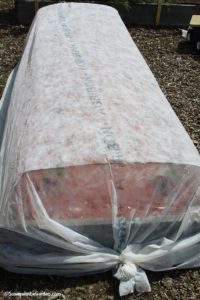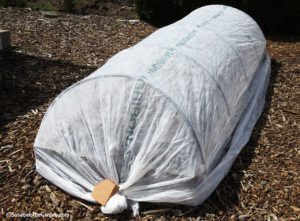Floating Row Cover
Please note that I no longer use tulle netting. Why? It’s just too fragile. In addition, the holes can let aphids through them which you definitely don’t want! Here are your two best alternatives, and they are awesome.
 Floating row cover is probably my favorite organic pest control product! It is a lightweight fabric that looks very similar to the interfacing used in shirt collars and cuffs.
Floating row cover is probably my favorite organic pest control product! It is a lightweight fabric that looks very similar to the interfacing used in shirt collars and cuffs.
It lets in air, light and moisture, and it also provides a few degrees of frost protection early and late in the growing season. But one of its best attributes is that it acts as a physical barrier against troublesome insects.
Here’s how you use it. Floating row cover works best when placed on hoops or some other form of support. Since it’s very lightweight, weigh down the ends and sides with bricks or boards. That way, it won’t blow off in a windstorm.
I use floating row cover over cabbage family crops. These include broccoli, cabbage, cauliflower and kale.) I also use it over beet family crops (spinach, beets, Swiss chard). It prevents cabbage butterflies or moths from laying eggs on the plants’ leaves. Those eggs hatch into very destructive caterpillars. It also prevents the adult leafminer fly from laying eggs on the beet family plants’ leaves. Let me tell you, it works GREAT!
 I use row covers for the entire season because none of the above crops needs to be pollinated. You also can use row cover early in the season over plants that will eventually need to be pollinated. That will give a warm environment to get started in. Once the plants begin blooming, those covers need to come off. That way, the pollinators can get to the flowers.
I use row covers for the entire season because none of the above crops needs to be pollinated. You also can use row cover early in the season over plants that will eventually need to be pollinated. That will give a warm environment to get started in. Once the plants begin blooming, those covers need to come off. That way, the pollinators can get to the flowers.
You can find floating row cover at well-stocked garden centers and online. It comes in many different lengths and widths so be sure to shop around for the size that works best. In Spokane, Northwest Seed & Pet carries it on a huge roll (you can buy it by the linear foot). To find it online, just do a search on “floating row cover.”
Row cover comes in different weights but the best, all-purpose weight is the lightweight version. Fortunately, it is also the least expensive! If you take good care of it, the row covers will last for years.
Agricultural insect netting is another (and even better IMHO) type of row cover. I started using it at the beginning of the 2022 garden season. It is extremely durable and the mesh is so fine, even aphids can’t get in. Gardenport is our online source for it.
Be sure to check out my row cover comparison video. That way, you can see exactly how I use both types.
